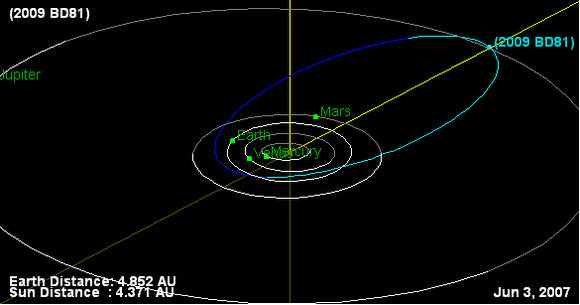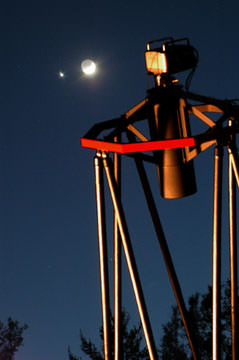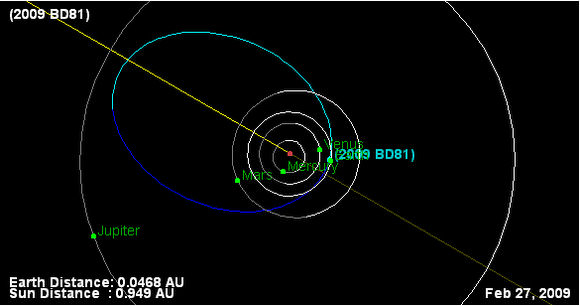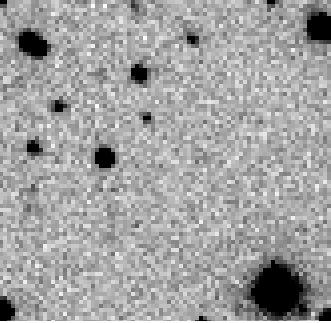[/caption]
While observing a known asteroid on January 31, 2009, astronomer Robert Holmes from the Astronomical Research Institute near Charleston, Illinois found another high speed object moving nearby through the same field of view. The object has now been confirmed to be a previously undiscovered Potentially Hazardous Asteroid (PHA), with several possible Earth impact risks after 2042. This relatively small near-Earth asteroid, named 2009 BD81, will make its closest approach to Earth in 2009 on February 27, passing a comfortable 7 million kilometers away. In 2042, current projections have it passing within 5.5 Earth radii, (approximately 31,800 km or 19,800 miles) with an even closer approach in 2044 2046. Data from the NASA/JPL Risk web page show 2009 BD81 to be fairly small, with a diameter of 0.314 km (about 1000 ft.) Holmes, one of the world’s most prolific near Earth object (NEO) observers, said currently, the chance of this asteroid hitting Earth in 33 years or so is quite small; the odds are about 1 in 2 million, but follow-up observations are needed to provide precise calculations of the asteroid’s potential future orbital path.
Holmes operates his one-man observatory at ARI, as part of NASA’s Near Earth Observation program and the Killer Asteroid Project. He also produces images for educational and public outreach programs like the International Astronomical Search Collaboration (IASC), which is operated by Patrick Miller at Hardin-Simmons University in Texas, which gives students and teachers the opportunity to make observations and discoveries.
In just the past couple of years, Holmes has found 250 asteroids, 6 supernovae, and one comet (C/2008 N1 (Holmes). However, he said he would trade all of them for this single important NEO discovery.
“I was doing a follow up observation of asteroid 2008 EV5,” Holmes told Universe Today, “and there was another object moving right next to it, so it was a pretty easy observation, actually. But you just have to be in the right place at the right time. If I had looked a few hours later, it would have moved away and I wouldn’t have seen it.”

A few hours later, teacher S. Kirby, from Ranger High School in Texas, who was taking part in a training class on how to use the data that Holmes collects for making observations used Holmes’ data measuring 2008 EV5 and also found the new object. Shortly after that, a student K. Dankov from the Bulgarian Academy of Science, Bulgaria who is part of ARO education and public outreach also noticed the new asteroid. Holmes listed both observers as co-discovers as well as another astronomer who made confirmation follow-up observations of what is now 2009 BD81.
Holmes is a tireless observer. Last year alone he made 10,252 follow-up observations on previously discovered NEO’s, more than 2000 more than the second ranked observatory, according to the NEO Dynamics website, based in Pisa, Italy.
Holmes has two telescopes, a 24-inch and 32-inch.

He works night-after-night to provide real-time images for the IASC program, uploading his images constantly during the night to an FTP site, so students and teachers can access the data and make their own analysis and observations from them. IASC is a network of observatories from 13 countries all around the world.
Holmes is proud of the work he does for education, and proud of the students and teachers who participate.
“They do a great job,” he said. “A lot of the teachers are doing this entirely on their own, taking it upon themselves to create a hands-on research class in their schools.” Holmes said recently, two students that have been involved with IASC in high school decided to enter the astrophysics program in college.
“I feel like we are making a difference in science and education,” he said, “and it is exciting to feel like you’re making a contribution, not just following up NEO’s but in people’s lives.”
Holmes also owns some of the faintest observations of anyone in the world.
“My telescopes won’t go to 24th magnitude,” Holmes said, “but I’ve got several 23rd magnitudes.”
“Getting faint observations is one of the things NASA wants to achieve, so that’s one of the things I worked diligently on,” Holmes continued. The statistics on the site bear that out clearly, which shows graphs and comparisons of various observatories.
To what does Holmes attribute his success? “It’s obviously not the huge number nights we have in Illinois to work,” Holmes said. The East-Central region of Illinois is known for its cloudy winter weather, when we often have our poorest astronomical “seeing.”
“However, I work every single night if it’s clear, even if it’s a full moon,” he said. “Most observatories typically shut down three days on either side of a full moon. But I keep working right on through. I found that with the telescopes I work with, I’ve been able to get to the 22nd magnitude even on a full moon night. Last year, I got about 187 nights of observing, which is the same number as the big observatories in the Southwest, when you take off the number of cloudy nights the 6 nights a month they don’t’ work around full moons. Sometimes you just have to work harder, and work when others aren’t to be able to catch up. That’s how we are able to do it, by working every single chance we have.”
He works alone at the observatory, running the pair of telescopes, and doing programming on the fly. “I refresh the confirmation page of new discoveries every hour so I can chase down any new discovery anyone has found,” he said. “If I just pre-programmed everything I wouldn’t have a fraction of the observations I have each year. I’d miss way too many because some of the objects are moving so fast.”
Holmes said some objects are moving 5,000 arc-seconds an hour on objects that are really close to Earth. “I’ve seen them go a full hour of right ascension per day and that’s pretty quick. They can go across the sky in four or five days,” said Holmes. “And there have been some that have gone from virtually 50 degrees north to 50 degrees south in one night. That’s was a screaming fast object, and you can’t preprogram for something like that, you actually have to be running the telescope manually.”

2009 BD81 is listed as a “risk” object on the NASA/JPL website. This is the 1,015th PHA discovered to date.
“It ranks high as a NEO in general,” said Holmes, “although not in a super-high category as far as the Torino scale,” which categorizes the impact hazard of NEOs. “At this point it’s considered a virtual impactor and that is typically is as high of a rating that you get at this point.”
“Because it is a virtual impactor, it will remain on that webpage and ask for observations every single night until it is removed as a virtual impactor or becomes too faint to see,” said Holmes. “In the past year, we’ve removed 23 virtual hazardous objects, which means there have been enough observations that the orbit of that object is no longer considered a threat to our planet.”

Because of the small number of observations of of 2009 BD81, the current chance of it hitting Earth is small. “The odds are really small right now,” said Holmes, “however, the smaller your orbital arc is the wider the path is at that point is of potential impact. The longer the arc gets, the narrower the cone of opportunity of impact becomes, and once that cone is no longer pointing at earth in the future, it is removed as a possible impactor.”
Holmes said the excitement of this discovery has been exhilarating. “It’s been a lot of fun. The energy level gets pretty high when you have something like this show up,” he said. “It’s pretty rare, and this is the first time I’ve ever had a NEO discovery. I’ve had several hundred asteroids, and just since the beginning of the school year we have had about 40 asteroids that students and teachers have discovered in the program. So having this as a NEO is kind of a nice thing.”
Holmes said he’ll track 2009 BD81 as long as he possibly can.
More information on 2009 BD81.
Holmes previously was a commercial photographer who had over 4,500 photographs published worldwide in over 50 countries. “At first astronomy was just a hobby in the evening,” said Holmes. “I worked with schools, who used the data and made some discoveries of supernovae and asteroids. It came to a point where it was really hard to work all day as a photographer and work all night in astronomy getting data for students.” So, he chose astronomy over photography.
Holmes now works under a grant from NASA to use astrometry to follow-up new asteroid discoveries for the large sky surveys and help students look for new asteroid discoveries for educational outreach programs.
One would assume that as a former commercial photographer, Holmes would attempt to capture the beauty of the night sky in photographs, but that’s not the case.
“The only thing I’m really interesting in is the scientific and educational aspect of astronomy,” said Holmes. “I’ve never taken a single color, pretty picture of the sky in the half a million images I’ve taken of the sky. It’s always been for research or education.”
Holmes is considered a professional astronomer by the Minor Planet Center and International Astronomical Union because he is funded by NASA, so that means he wasn’t eligible to receive the Edgar Wilson award when he found a comet last year.
Because of Holmes outstanding astronomical work, he is also an adjunct faculty member in the physics department at Eastern Illinois University in Charleston, Illinois.


huuummm, good size, if average impact speed 18mps, average density, if it survives to the surface, a 5 mile diameter crater, with a total destruction radius of 100 miles- what a way to go! Well, I guess a zillion people are going to tear up my calulations, oh well, lol.
well at least it isnt a world ending asteroid maybe its a good chance to work on deflection techniques seeing as how its so small nothing really big would need to be constructed to deflect it.
jake-yes, if it appears it has the names of a few small countries or states or decides to take a plunge in the ocean, we can use some persuasion to deflect 2009 BD81 away from Earth- at least there’s plenty of time to think about methods to use if required.
The simple methods I used took 30 seconds in my head and was based on a ‘straight down hit’ of 18 miles per second, hitting the surface and merely used 20x times diameter of the ‘rock’, 20x diameter of crater for radius of total utter destruction 100miles, and should add another 20x for a distance of about 2000 miles radius from ‘ground zero’ for people who will have a bad day from broken glass and roof damage at edge of 2000 mile radius,- for people much nearer to the radius of total destruction, well,they better be deep underground!. Such a ‘rock’ I believe wll have the combined megatonnage, perhaps up to 12x , of all nuclear warheads of the world before start2 treaty brought that figure down. .I read a report some time back, both the US and the former Soviet Union were thinking of using a a few monster 10,000MT warheads, of course, such a warhead to too large for any space vehicle, so they were going to be placed on hugh ‘cargo ships’ and set off in harbors of St.Petersburg (Leningrad) , Vladivoskok, San Francisco, New York,etc. however, wiser heads prevailed and such monsters were not made. There are far too many ways the ‘rock’ will track should it hit the Earth and such calculations is beyond my knowledge- lets just hope we can use some persuasion to deflect the rock if required.
Probably a really dumb question. Could the effects of global warming be cancelled out by the occasional largish asteroidal impacts? Surely the “winters” caused by atmospheric particles after impacts would have a long term effect of reducing global temperatures? By stopping the natural process of impacts could therefore be detrimental to the global climate.
Re: global warming – no. Dust and ash has a very short atmospheric lifespan compared to CO2. Thinks years vs centuries. A good proxy for a city-destroying rock is a large volcanic eruption, which might disrupt weather patterns for a year or two but have little impact on climate patterns.
As you start looking at bigger rocks, you can have lasting impacts (no pun intended) on climate, but you’ve probably killed everything on the planet first by drastic short-term impacts on weather.
We need more people like this fine individual. He is dedicated and professional by every means possible. Someone I now respect and look up to. Please post more stories like these. I think it reminds us all why we love astronomy.
[…] El 31 de enero de 2009, Robert Holmes, un astrónomo del Astronomical Research Institute (EE.UU.), observaba un asteroide conocido cuando […] Fuente: Nancy Atkinson para Universe Today […]
What’s Global Warming? Too bad it doesn’t exist — could use some here in Kentucky USA right now!
@mitkilurt – I’ll second that! I’m sure a lot of amateur astronomers would agree that if there were an affordable 32″ telescope on the market we would love to be doing this type of work. 😉
Excellent article, Nacy! Looking forward to updates on 2009 BD81.
“Elementary, my dear Watson.”
Way to go, Robert! Excellent and very interesting story.
YOu know what that is?
NIBIRU, google it up, The end could be comming
/end
I agree we need many more people like Robert Holmes,- the asteroid he discovered -2009 BD81-althought not the ‘dreaded rock’ that broke the dinosaurs’ back, will still cause a catastrophe many,many magnitudes greater than anything in modern recorded history (since c. 1800 as anything before is ?!?) and capable of killing hundreds of millions quickly/directly and eventually killing many hundreds of millions more due to wars caused by mass migrations/competition for resources ,hunger, diseases. There are many more of these ‘continent disrupting rocks’ than the ‘big daddy dino back breaker rock’ we dread . The rough estimate I posted at 2000 mile radius for a surface hit-to break glass, destroy chicken coups and do some damage to some rooftops shows even the countries with the largest landmass will be totally disrupted (even Russia will hear/feel the ‘hit’ at the least !! ) and can destroy the economies of even the richest countries in the world should they be struck by a ‘rock’ the size of .2009 BD81 . Needless to say, much more resources and people like Robert Holmes is needed.
Another asteroid threat? 2012? Peak oil? Climate change? War with Iran? Hurricane $eason coming soon? Cancer cell phone causing strange growths?
Man! All these problems piling up… and I’m still struggling with Y-2K!
One day at a time!
“Elementary, my dear Watson.”
Way to go, Robert! Excellent and very interesting story..
The first orbital diagram for 2009 BD81 in the article, for June 3rd 2007, shows it at aphelion, out near Jupiter’s orbit. The orbital period of the object is given, elsewhere, as 1504 days. If you do the math, this seems to clearly indicate that the object will again be at or near aphelion during all of the year 2044. If this is correct, how will it have a close encounter with Earth in that year? Have have missed something here? Michael
robbi theres no reason to be rude
jake=there is no intent on my part to be ‘rude’,
it is just my way to say the scale of misery will be great and will wake people up to how serious the problem can be.. Using ‘conventional speak’ can bore people and can cause people to be unconcerned about the true potential disaster.
I am one of the teachers who has had an opportunity to bring your images into the classroom for my students. We are participating in the IASC program searching for asteroids and actually were able to discover two new ones. My students are very enthusiastic to be a part of the program. I would like to thank you for all your hard work and dedication to astronomy. I know this experience for my students will last them a lifetime and hopefully lead them to a career in Science. It only takes a spark to light a fire.
jake- I should’ve also noted should the ‘rock’ hit the Earth, the LOCATION of the hit can be very important!!! Human nature, chaotic as it is, the secondary effects of the ‘rock’ hit can be much worst-both the US and Russia are still armed with about 5k warheads each and if there is competition for resources that has been disrupted or destroyed, misunderstanding can easily cause both countries to start heaving or dropping these warheads on each other, while the other nations with nuclear warheads will heave theirs who knows where, this can probably cause 1-3 billion killed by direct effects, famine,diseases. I sometimes wonder what is worst, the rock that broke the dinos’ back or this ‘continent disrupting rock’- at least if we get hit by the dinos’ back breaker rock, it will spread the pain somewhat equally and whatever ‘war’ there may be will be more liken to a bar-room brawl or a soccer riot on a wide front as all of the weapons, even rifles will eventually quit working in such a corrosive atmosphere!
I hope if we get hit by a rock per this feed, it hits Antarctica-there is no study made on such a ‘small hit’ for Antarctica, but I’m certain it is more than a bunch of Penguins diving into the water to escape the heat-as far as the people doing research in Antarctica, well, it will just have to be part of a research to figure out how they really died.
This is really strange…
but I had a dream in 1996, that an asteroid hit the Indian Ocean in 2042, and caused a severe tidal wave that destroy a lot of the Indian coast line… I woke up in shock, and realized I probably wouldn’t be alive at that time….
Ed- Lol, I hope if my city has the ‘rock’ name written on it, I’m sleeping so I won’t have the ‘opportunity’ to ‘wake up’ to find out what happened! lol
Be sure to get your Asteroid Armor then:
http://geddongear.com/AsteroidArmor.aspx
LMAO!